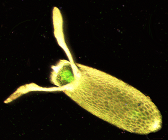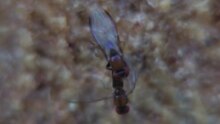Fruit flies
| Fruit flies | ||||||||||||
|---|---|---|---|---|---|---|---|---|---|---|---|---|

Black-bellied fruit fly ( Drosophila melanogaster ) |
||||||||||||
| Systematics | ||||||||||||
|
||||||||||||
| Scientific name | ||||||||||||
| Drosophilidae | ||||||||||||
| Rondani , 1856 | ||||||||||||
| Subfamilies | ||||||||||||
|
The fruit flies (Drosophilidae), also called fruit, fermentation, must or vinegar flies , are a family of flies (Brachycera) within the order of the two-winged (Diptera). They are small flies, only about one to six, mostly two millimeters in size, that can be found almost everywhere: in damp deciduous forests and on the edges of forests, but also in the vicinity of human dwellings. They are attracted to rotting fruit and leftover drinks in open bottles, from whose fermenting substances they feed. The German trivial name "Obstfliegen" can be traced back to this predilection for rotting fruit. The name "fruit flies" is derived from the behavior of the animals. They mostly fly in the mornings and evenings, i.e. at those times when dew is often deposited .
Over 3000 species are known worldwide. About 50 of them live in Germany. A distinction is made between wild species, which are ecologically tied to woody plants, and cultural followers , which have adapted to human habits and live mainly in compost and wherever fruit is stored or fruit juices ferment. Examples of culture followers are Drosophila melanogaster , Sophophora simulans , Drosophila funebris , Drosophila busckii , Drosophila immigrans , Drosophila hydei and Drosophila repleta . Some game species are also found in gardens, some even in houses, such as Sophophora subobscura and Drosophila limbata . Some of the cultural followers can also be found outside of settlements, but they cannot establish permanent populations there .
The best known is the species Drosophila melanogaster , which becomes two to three millimeters long, is yellow-brown in color, has black abdominal rings and red eyes and became a standard subject of genetics in the 20th century .
Development and larval stages
With many species of fruit flies, there is a courtship before mating , which can be divided into several phases. The first phase involves detection, in which the male touches the female with the front feet. Especially virgin females secrete a sexual attractant that the males can perceive over short distances. The identification is obviously chemical, since the male withdraws when touching foreign females. In a second phase, there is an optical orientation in which the male circles the female and runs after him. This phase only occurs in diurnal species, facultative nocturnal species such as Drosophila melanogaster do not. In the third phase, both sexes slowly open their wings and close them again, whereby the number of these actions and the exact behavior is species-specific. The fourth phase begins with the male vibrating with its wing pointing towards the female, continuing to circle the female. The air flow generated in this way is perceived by the females with the help of Johnston's organs located in the antenna bases. In many species, the female responds to vibration by vibrating her wings as well. The male then touches the female's sexual region with his trunk and the first attempt at copulation takes place directly on this . The male tries to climb onto the female's abdomen, but is usually repulsed several times. If the female is not willing to mate, it will flee. The courtship ritual can be repeated several times for stimulation until mating occurs.
The females of the fruit flies lay up to 400 eggs in fermenting plant substances or other substrates that can later serve as food for the larvae . The eggs are shaped typical of the species and have specific respiratory appendages with a plastron .
Like other fly larvae , the larvae that hatch from it go through three stages in the form of a typical maggot stage . Most larvae are saprophagous , so they feed on dead plant remains or rotten fruits, in particular here they eat the microorganisms that decompose the fruits, for example yeasts and bacteria . Others are phytophagous and live as miners in plant stems or leaves. One of these is Scaptomyza flava , which can become a nuisance when there are large numbers of crops, especially cruciferous vegetables . Still others develop in fungi ( e.g. Drosophila transversa ) and some, e.g. B. Acletoxenus formosus , even feed predatory on insects that suckle on plants. Cacoxenus indagator larvae live in the nests of solitary bees and feed on their nectar and pollen stores .
The first larval stage of fruit flies is metapneustic, i.e. has only one open stigma opening at the end of the abdomen, the other two stages each have an open stigma opening at the front and rear end and are therefore amphipneustic.
At the end of development a brown barrel pupa forms , which may overwinter . The doll has typical prothoracic squirrels that help the dolls breathe. Often several generations of fruit flies develop each year. Depending on the type of fruit flies and environmental influences, development can take from seven to over 60 days.
Economical meaning
Draft flies are generally considered a nuisance rather than a pest , as most species reproduce in rotting material. Exceptions are Zaprionus indianus that in Brazil of figs feed, as well as Drosophila suzukii that of thin-skinned fruits such as raspberries and cherries lives.
The larvae of Drosophila repleta live in sewers and transmit bacteria.
It is generally believed that fruit flies spread acetic acid bacteria and in this way disrupt alcoholic fermentation by stimulating acetic acid fermentation .
behavior
Researchers found that female fruit flies prefer to lay their eggs in rotting fruits that are already alcoholically fermenting when the flies perceive female endoparasitoid wasp larvae in the vicinity . Fly larvae serve as host organisms for wasps, but they are more sensitive to alcohol than fly larvae.
Systematic classification
The Drosophilida belong in the order of the Diptera to the Brachycera , the "short-feeling" (in contrast to the mosquitoes , the "long-feeling"). Within the Brachycera they belong to the cyclorrhaphic Schizophora. The Cyclorrhapha ("Rundspaltige") are characterized by the already mentioned barrel doll. They got their name because the ready-to-hatch fly breaks the lid of the doll at a circular gap. The force for this detonation comes from a bubble that forms between the forehead and face of the fly. After the fly has left the pupal shell, this bubble recedes. However, there remains a seam between the forehead and face, which gave them the name "Schizophora", "split bearer". Within the Cyclorrhapha the fruit flies belong to the Acalyptrata (the "uncovered"), these are those families whose swinging bulbs are not covered by two scales (in contrast to the Calyptrata ).
The family of Drosophilidae is divided into two subfamilies, Steganinae and Drosophilinae, which differ, for example, in the leg bristles and the structure of the vaginal plates.
The genera belong to the Steganinae:
The genera (with selected species) belong to the Drosophilinae:
Fossil evidence
Fossil members of this family are very rare and known almost exclusively from tertiary age amber . Evidence of fruit flies is available from Eocene Baltic amber and the somewhat younger Dominican amber . On the latter site, two fruit flies that were infested with mites and nematodes were also trapped by the resin .
Note on the term "fruit fly"
Originally only flies from the family Tephritidae ( drill flies ) were referred to as "fruit flies" in German usage . In order to avoid confusion, the German name "Taufiegen", which has long been established, is used in this article.
literature
- G. Bächli, H. Burla: Insecta Helvetica 7: Diptera - Drosophilidae. Swiss Entomological Society 1985.
- Christiane Nüsslein-Volhard , Eric F. Wieschaus : Mutations affecting segment number and polarity in Drosophila. In: Nature 287, 1980, pp. 795-801.
- Martin Brookes: Drosophila. The success story of the fruit fly. Reinbek 2002.
Individual evidence
- ↑ Pest Alerts - Zaprionus indianus Gupta, DPI . Florida Department of Agriculture and Consumer Services. Archived from the original on October 12, 2013. Info: The archive link was inserted automatically and has not yet been checked. Please check the original and archive link according to the instructions and then remove this notice. Retrieved October 5, 2013.
- ^ Drosophila suzukii Center of Invasive Species Research
- ↑ Vinegars of the World. Chapter 5. ISBN 978-88-470-0865-6 .
- ↑ Kacsoh BZ, Lynch ZR, Mortimer NT, Schlenke TA: fruit flies medicate offspring after seeing parasites . In: Science . 339, Feb 2013, pp. 947-950. doi : 10.1126 / science.1229625 . PMID 23430653 . PMC 3760715 (free full text).
- ↑ George O. Poinar, Jr .: Life in Amber . 350 pp., 147 figs., 10 plates, Stanford University Press, Stanford (Cal.) 1992. ISBN 0-8047-2001-0
- ↑ Family DROSOPHILIDAE fossil Diptera
- ^ Stefan von Kéler : Entomological dictionary. Akademie-Verlag, Berlin 1963.
Web links
- Fam.Drosophilidae: fruit flies, vinegar flies ( Memento from July 4, 2008 in the Internet Archive )
- Flying Heat - Global warming is causing the fruit flies to evolve rapidly. In: Telepolis
- The new genus Sophophora. In: faz.net





